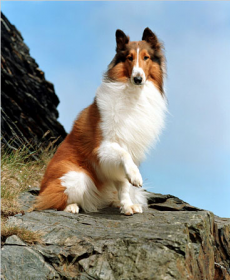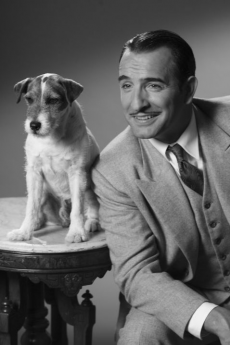
Lassie
Lassie is a fictional collie dog first created by Eric Knight in his short story Lassie Come-Home, published in The Saturday Evening Post in 1938, which he expanded into a novel in 1940. The first Lassie movie had the same title, and was released in 1943. Set in 1930s England, it portrayed the long journey Lassie made to be reunited with her young owner, after his family is forced to sell her for money.
The film was a great success, and was followed up by a sequel and several spin-offs, including a television show from 1954-1973. Lassie is one of very few fictional characters to have received a star on the Hollywood Walk of Fame. The same dog, named Pal, played Lassie in all the films up until 1951, and even performed his own stunt work. He helped pick the TV series’ main actor, Tommy Rettig, but retired himself after filming two pilot episodes. His son, Lassie Junior took over the role instead, and since then Pal’s descendants have continued to play the famous role.
Old Yeller
Old Yeller is a family tragedy film from 1957, based in post-Civil War Texas. It tells the story of Travis and Arliss, young boys who find a stray dog while working in the cornfields. The dog—whom they name ‘Old Yeller’ due to his yellow coat—is mischievous but loyal, and helps the boys through many adventures. The film’s tragic ending has become extremely famous, and it is often rated as one of the best boy-and-his-dog films. Old Yeller was played by a lop-eared Mastador named Spike.
Toto from The Wizard of Oz
Toto first appeared in L. Frank Baum’s children’s book The Wonderful Wizard of Oz. He is the loyal pet of the book’s protagonist Dorothy Gale, with whom he lives on isolated farm in 1900s Kansas. The most well-known adaptation of Baum’s book was the 1939 musical The Wizard of Oz, starring Terry the dog as Toto and Judy Garland as Dorothy. Terry was paid $125 a week, more than many of the human actors! Due to the popularity of the role, Terry’s owner had her name officially changed to Toto in 1942.

Hachi: A Dog’s Tale
Hachikō was an Akita dog from Japan, born in 1923. Every evening Hachikō would greet his owner, Hidesaburō Ueno, on his return from work at the University of Tokyo. Every evening the dog would wait at Shibuya Station for Ueno, until May 1925 when the professor didn’t arrive; he had suffered a cerebral haemorrhage, and would never come home again. Nevertheless, for the next nine years and nine months, Hachikō continued to appear at the station, waiting for his owner’s return. Soon he became a national sensation, as a symbol of love and loyalty, and commuters began to bring him food and treats.
Hachikō has been the subject of two films, a 1987 Japanese one called Hachi-kō Monogatari, or The Tale of Hachiko, and a 2009 American one called Hachi: A Dog’s Tale.
The Artist
In 2011 this French romantic comedy-drama was released, made in the style of a classic black-and-white silent film. It tells the story of George Valentin, an ageing silent movie actor and his relationship with younger actress Peppy Miller, as silent movies lose out to the new ‘talkies.’ Uggie the dog played the role of Valetin’s pet Jack, and many critics described him as stealing every scene. Like his puppy predecessor Pal, Uggie did all of his own stunt work. When it began to seem likely that The Artist would receive BAFTA awards a ‘Consider Uggie’ campaign was launched, calling for official recognition of his performance. However, the Academy responded that “as he is not a human being and as his unique motivation as an actor was sausages, Uggie is not qualified to compete for the BAFTA in this category." Uggie did go on to win the Palm Dog award at the 2011 Cannes Film Festival.
Images: http://www.counter-currents.com/wp-content/uploads/2011/10/Lassie.jpg
http://www.cinechronicle.com/wp-content/uploads/2012/01/The-Artist.jpg

0 Comment:
Be the first one to comment on this article.